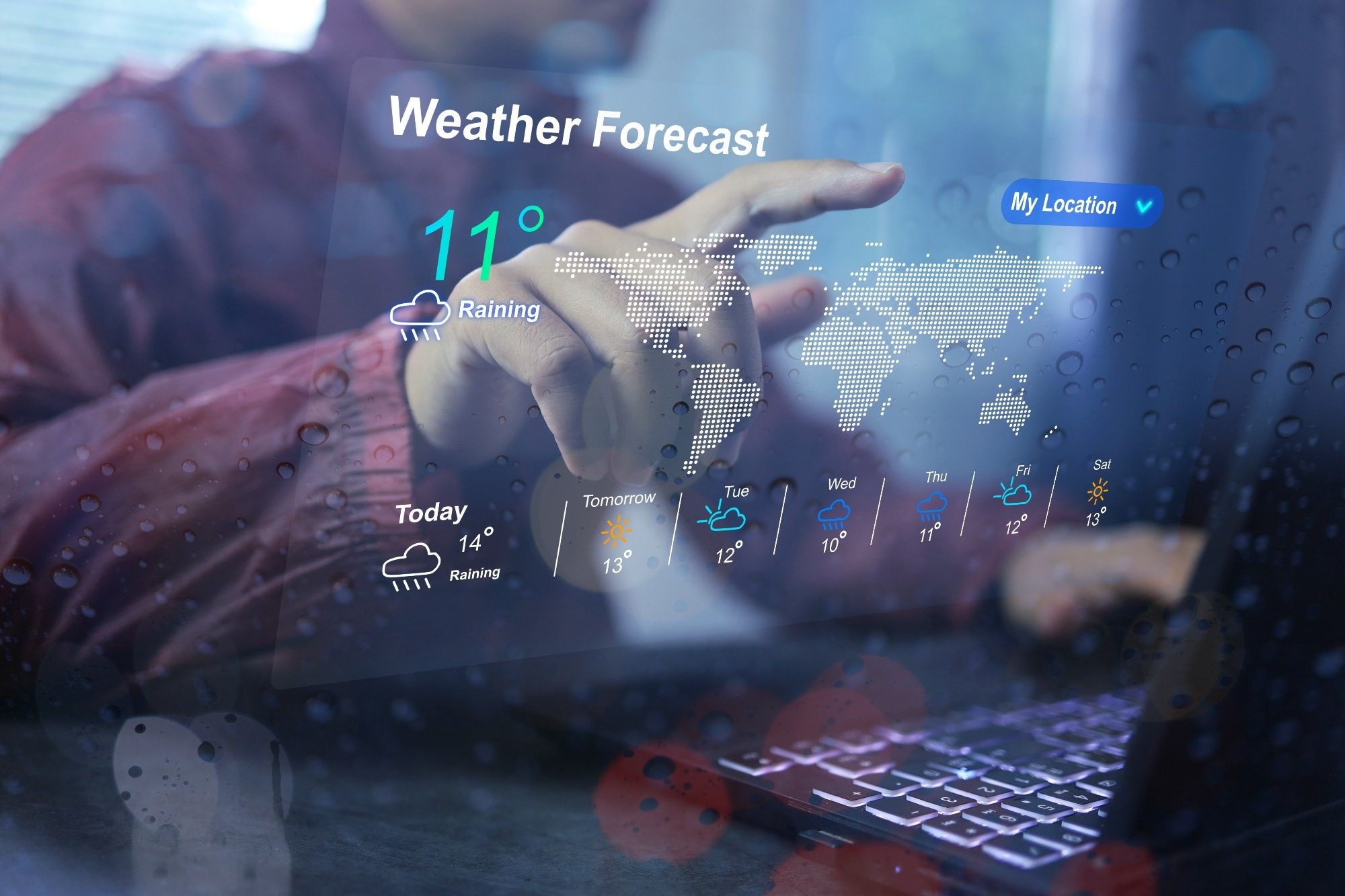In a paper published in the journal Nature Communications, researchers introduced fuxi subseasonal-to-seasonal (FuXi-S2S), a machine-learning (ML) model that forecasted global daily means up to 42 days ahead. Trained on 72 years of European Centre for Medium-range Weather Forecasts (ECMWF) data, FuXi-S2S surpassed ECMWF's state-of-the-art model in predicting precipitation and outgoing longwave radiation. Its improved accuracy was attributed to better handling of forecast uncertainty and enhanced madden-Julian oscillation (MJO) predictions, extending skillful MJO forecasting from 30 to 36 days. This advancement offered valuable insights and potential breakthroughs in earth system science research.
 Study: FuXi-S2S: A Machine Learning Model to Forecast Weather. Image Credit: Aree_S/Shutterstock.com
Study: FuXi-S2S: A Machine Learning Model to Forecast Weather. Image Credit: Aree_S/Shutterstock.com
Related Work
Past work highlighted the challenge of subseasonal forecasting, bridging short-term weather and long-term climate predictions. Traditional ensemble prediction systems (EPS) faced limitations due to biases and computational constraints. ML models showed promise but needed help with ensemble generation. The challenges in subseasonal forecasting include addressing biases and computational constraints in traditional ensemble prediction systems and overcoming limitations in ensemble generation with ML models. These hurdles have historically impeded accurate and reliable subseasonal predictions.
Model Overview
The European reanalysis for the fifth generation (ERA5) of the ECMWF reanalysis dataset is renowned for its comprehensive and precise coverage of surface and upper-air variables with a temporal resolution of 1 hour and a horizontal resolution of approximately 31 km. It serves as the sole data source for training the FuXi-S2S model.
Alongside ERA5, the team uses the climate prediction center (CPC) backward-outgoing longwave radiation (OLR) dataset, which spans from 1991 to the present with near real-time updates. The Climate Bureau Observatory (CBO) dataset, with a spatial resolution of 1° and a temporal resolution of 1 day, serves as the ground truth for OLR in MJO event identification and verification. The MJO indices obtained from ERA5 OLR data are in close agreement with those from the CBO dataset.
The FuXi-S2S model forecasts 76 variables, including 5 upper-air atmospheric variables across 13 pressure levels and 11 surface variables. Surface variables include 2 m temperature, sea surface temperature, OLR, wind components at various heights, mean sea-level pressure, total column water vapor, and total precipitation.
Sea surface temperature (SST) is included based on prior research suggesting its importance in identifying predictable signals, and OLR is selected for its role in representing MJO events through anomalies. Z-score normalization ensures uniformity in mean and variance across input and output variables. For 2022, the dataset is used to evaluate and compare against ECMWF real-time S2S forecasts, particularly focusing on catastrophic flooding in Pakistan.
The FuXi-S2S model, inspired by variational autoencoders (VAEs), employs a probabilistic approach to generate ensemble forecasts. Its architecture includes an encoder that transforms input data into a Gaussian distribution in the latent space and a decoder that combines samples from this distribution with a static hidden feature to generate forecasts.
The training process includes autoregressive steps with a curriculum schedule and utilizes 51 ensemble members. The model is optimized using the AdamW optimizer with specific hyperparameters, and a bootstrapping approach is used for significance testing to compare the performance of FuXi-S2S with ECMWF S2S. These maps, generated through backward propagation, highlight areas critical to accurate predictions based on gradient intensities.
The saliency of predicted anomalies relative to the input data is analyzed to ensure the model's alignment with established physical understanding. For evaluation, each variable's forecasts undergo detrending to remove linear trends. The MJO is characterized using the real-time multivariate MJO (RMMMJO) index, and forecast quality is assessed using a bivariate center for ocean-atmospheric prediction studies (COR) for amplitude and phase.
FuXi-S2S Performance
The study thoroughly evaluates the performance of the 51-member FuXi-S2S forecasts against the 11-member ECMWF S2S forecasts from 2017 to 2021. The analysis covers various forecast lead times, focusing on weeks 3 to 6, and includes deterministic and probabilistic metrics and specific assessments for extreme events like the 2022 Pakistan floods. FuXi-S2S forecasts show notable improvements over ECMWF S2S in predicting total precipitation (TP) and outgoing longwave radiation (OLR), though they perform similarly or worse in forecasting 2-meter temperature (T2M) and geopotential at 500 hPa (Z500).
Probabilistic metrics further illustrate FuXi-S2S's superior performance in predicting TP in tropical regions and some extra-tropical regions, while ECMWF S2S retains an edge in certain tropical areas. The model also demonstrates better skill in forecasting extreme precipitation events and the MJO, extending skillful forecasts beyond ECMWF S2S. In evaluating the 2022 Pakistan floods, FuXi-S2S provided more accurate early predictions of extreme rainfall than ECMWF S2S, particularly for forecasts initialed around July 21st.
The estimates' spatial distributions and saliency maps reveal that FuXi-S2S effectively captured precursor signals, including SST anomalies in the tropical Pacific and Indian Oceans, which were critical in predicting the intense monsoon rainfall. The study highlights the value of FuXi-S2S in capturing essential precursor signals and improving subseasonal forecasting capabilities, particularly in extreme weather events.
Conclusion
To summarize, FuXi-S2S demonstrated significant improvements over ECMWF's model, providing global daily forecasts for up to 42 days across various atmospheric and surface variables. Trained on 72 years of ECMWF ERA5 data, FuXi-S2S excelled in predicting total precipitation and outgoing longwave radiation, capturing forecast uncertainty, and extending MJO predictions from 30 to 36 days. It also proved valuable for identifying precursor signals, potentially advancing Earth system science research.